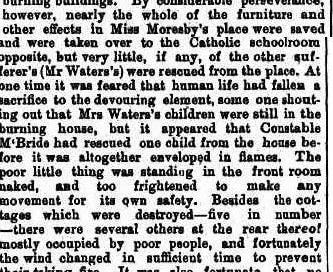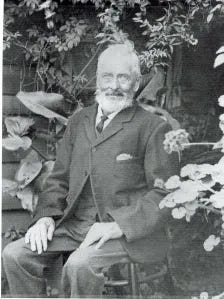My 2x great grandparents Thomas WATERS and Anne COCK were living in Kyneton, Victoria, Australia, with their five small children, when in June 1865, their house caught fire, and they lost all of their belongings. At the time, with their growing family, they were struggling to make ends meet.
About one year earlier, Thomas had been injured in an explosion, losing his sight in one eye, and losing the use of one hand. Due to these injuries, Thomas obtained a position as a solicitor’s clerk, as he could no longer do the farm work that he preferred. The clerical work was poorly paid, so his wife Ann took in washing to help make ends meet.
Between 1862 and 1871, Thomas wrote letters to his family in Bedfordshire, England, where he described the turmoils of his life in Australia.
Thomas Waters
Destructive Fire at Kyneton
From: The Leader, Saturday 17 June, 1865, page 51
We take the following particulars of the fire at Kyneton, from the Observer: — ‘The town was startled between eight and nine o’clock on Saturday evening last, by the cry of fire resounding through the streets, and it was discovered that the row of wooden premises in Hutton-street facing the Independent Chapel was on fire. The smoke was first seen issuing from a two-story wooden building occupied by a person named Waters, and before any attempt could be made to save the building, it was in full flames.
Simultaneously, with the flames bursting forth from this house, they were also seen issuing from the house adjoining, an empty one, and which was part of the same building, but divided by a stone party wall. The wind was blowing strong at the time, and it soon became evident, that it would be a matter of impossibility, to save any of the wooden buildings adjacent to those on fire.
By the time the two houses were on fire, a large crowd assembled, and every effort was made to save the furniture and other effects in the blazing houses. A right-of-way divided the two houses now on fire, from another row of wooden cottages occupied by Miss Moresby as a ladies’ seminary, and these very soon fell victims to the devouring element, while on the other side of the buildings, where the fire originated, the house and shop of Mr Humphries quickly shared the same fate.
All being of wood, it was impossible to save them, and the wind, which was very strong during the whole time the fire was burning, blew the flakes of fire fiercely about and rendered it a difficult matter for those around to attempt to save the furniture within the burning buildings.
By considerable perseverance, however, nearly the whole of the furniture and other effects in Miss Moresby’s place were saved, and were taken over to the Catholic schoolroom opposite. But very little, if any, of the other sufferer’s (Mr Waters’s) were rescued from the place. At one time, it was feared that human life had fallen a sacrifice to the devouring element, some one shouting out that Mrs Waters’s children were still in the burning house.But it appeared that Constable McBride had rescued one child from the house before it was altogether enveloped in flames. The poor little thing was standing in the front room naked, and too frightened to make any movement for its own safety. Besides the cottages which were destroyed — five in number —there were several others, at the rear thereof, mostly occupied by poor people, and fortunately the wind changed in sufficient time to prevent their taking fire. It was also fortunate that no wooden buildings immediately faced the burning pile, as had there been any, they must not only have been destroyed but formed a connecting link to have carried the fire further on. One house on the opposite side of the way, but at a considerable angle with the houses on fire, caught several times, and it was only by the continued application of wet blankets it was saved from destruction.
From the time the fire first broke out, to the destruction of the entire group of buildings, scarcely an hour elapsed, but, during the time it lasted, the heat was most intense, and the entire town was lighted up.
The actual origin of the fire appears to be involved in mystery, though there is but little doubt it was in the rear of the empty house referred to, that it originated; and it is supposed that the workmen who were at work therein carelessly left a light burning. There were altogether five houses totally destroyed, and of course a considerable quantity of both Mr Humphries’s and Mr Waters’s furniture, &c.
We understand that Mr Humphries, the owner of the two houses where the fire first broke out, as well as the one adjoining, was insured, for the first £85, and for the latter £50. The others, which belonged to Mr Ellis, were uninsured.
But little, if any, water was obtainable during the whole time the fire was raging, nor was there any attempt beyond individual effort at saving property. Several towns people, as well as the Rev. Father Geoghegan, Mr Stiles, of the Bank of New South Wales, and other gentlemen, did good service, and materially aided in the removal of such things as were saved. Miss Moresby had recently taken the Crown Hotel as an academy, so that, fortunately, beyond the unavoidable loss by the removal of her furniture, she suffers no material inconvenience.
#Please note: Alterations have been made to punctuation for ease and speed of reading.
There is a link below to the final letter sent to Bedfordshire with links at the bottom, to all letters.
DESTRUCTIVE FIRE AT KYNETON. (1865, June 17). Leader (Melbourne, Vic. : 1862 – 1918, 1935), p. 5. Retrieved March 18, 2021, from http://nla.gov.au/nla.news-article197034473






